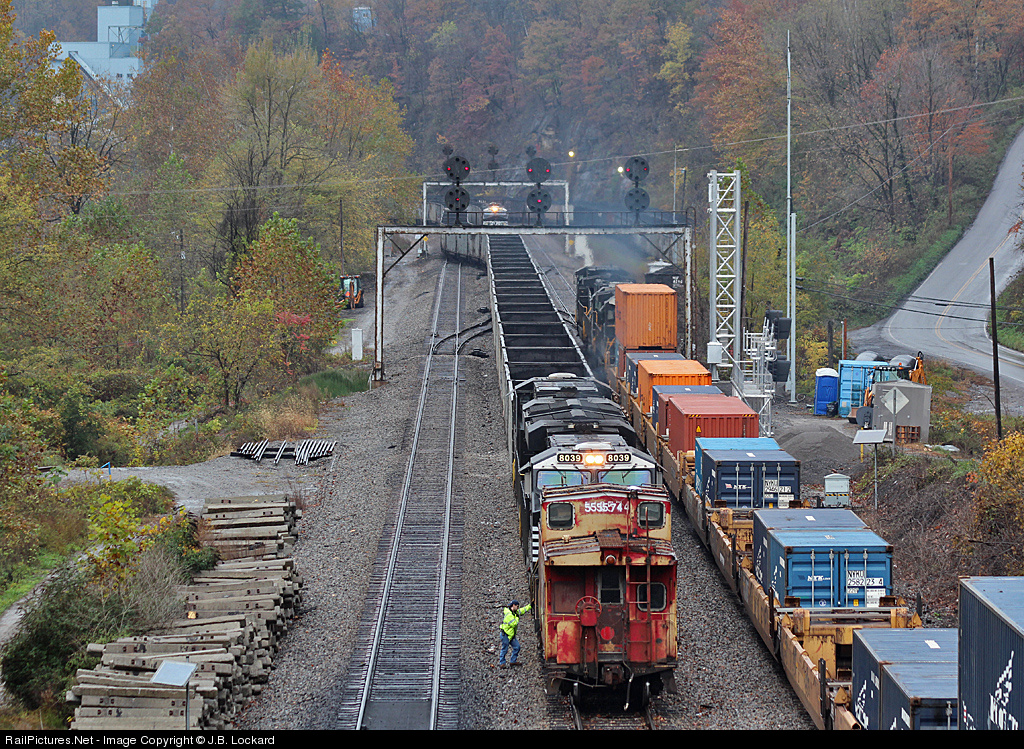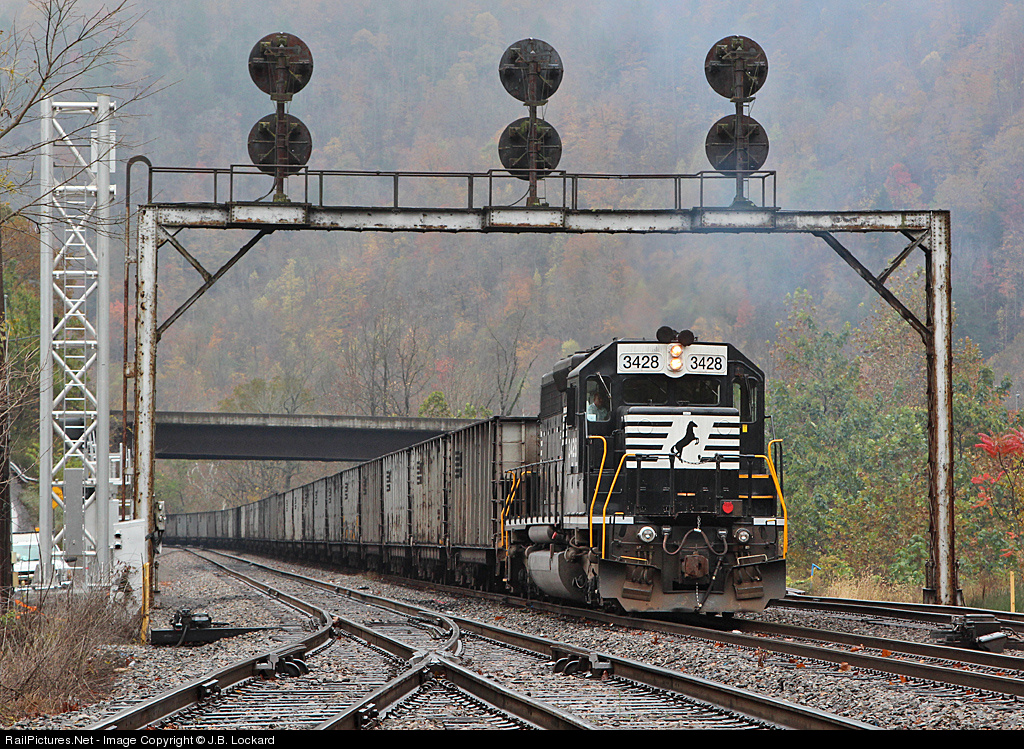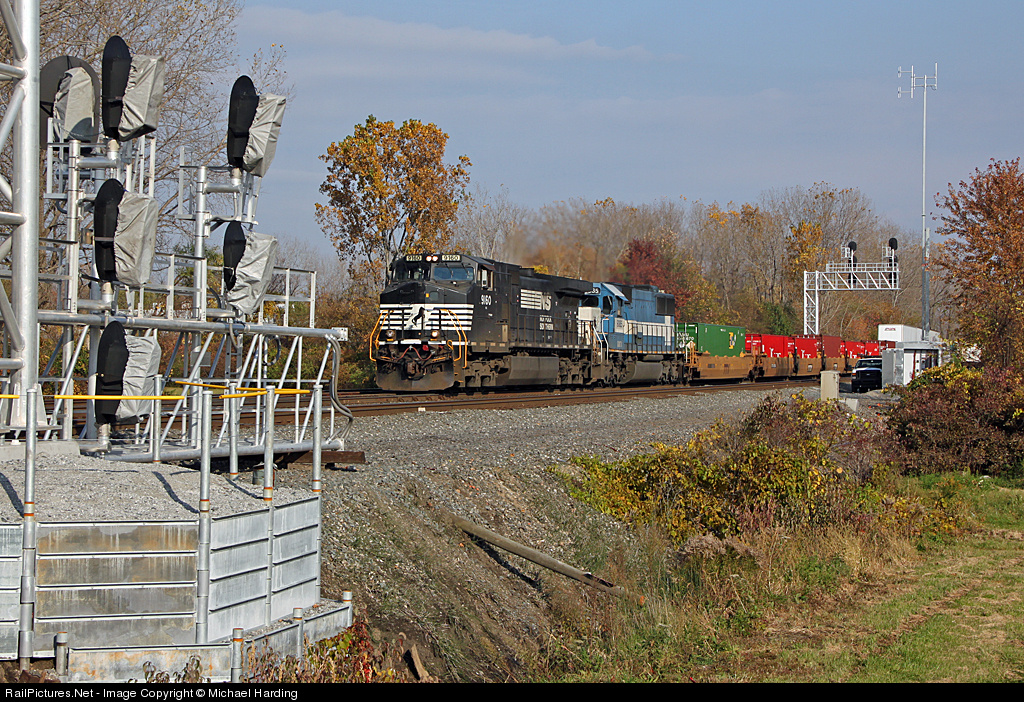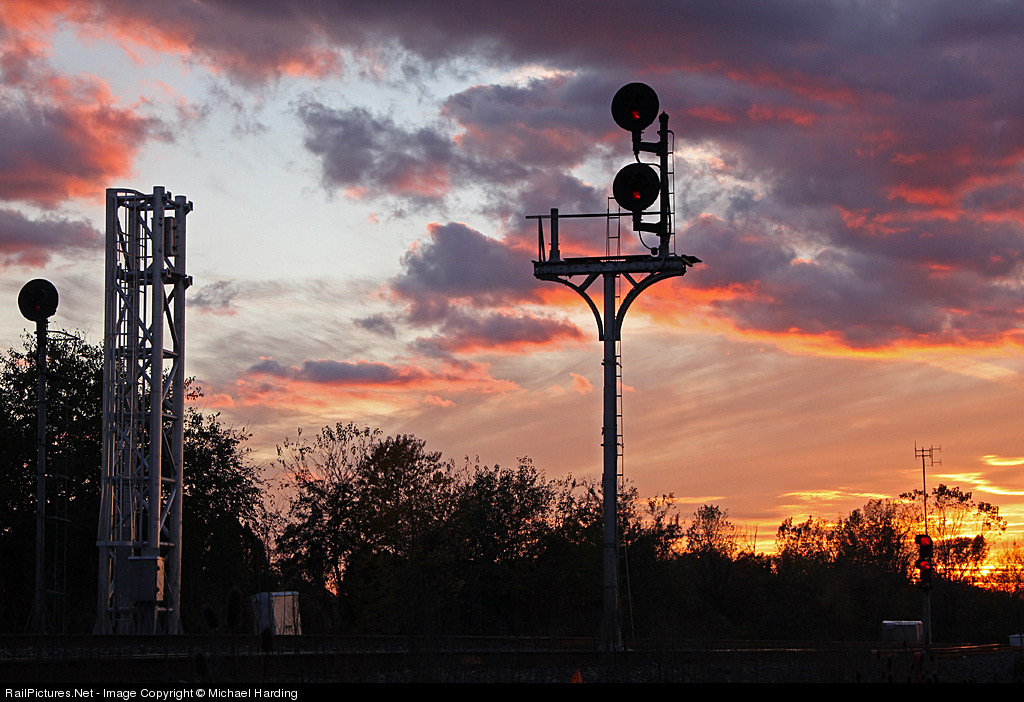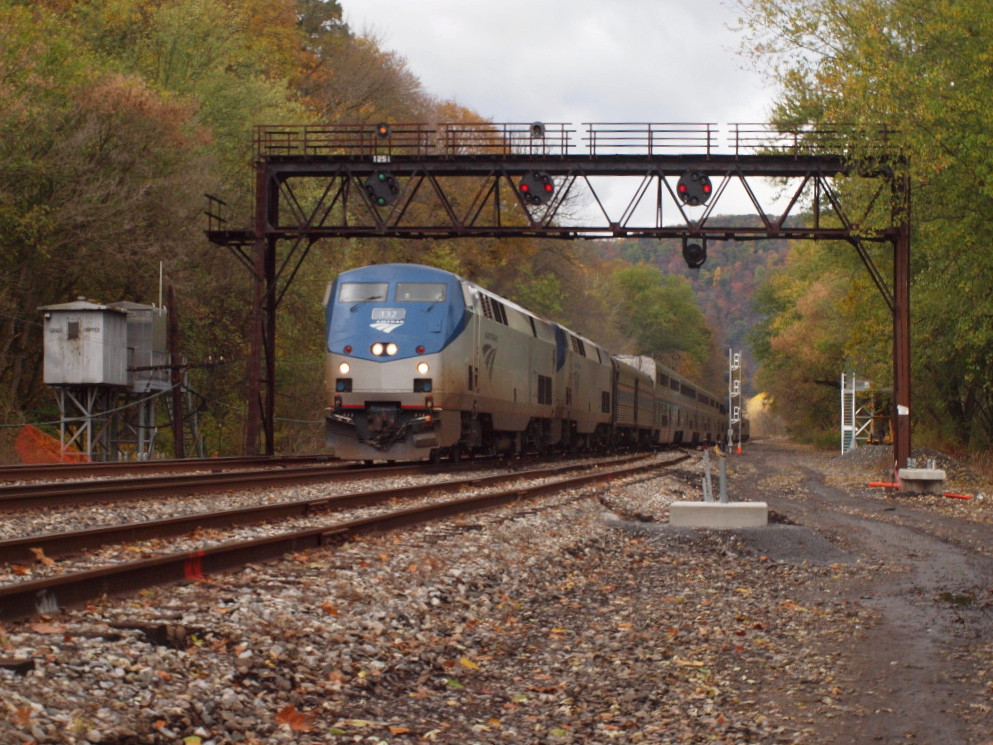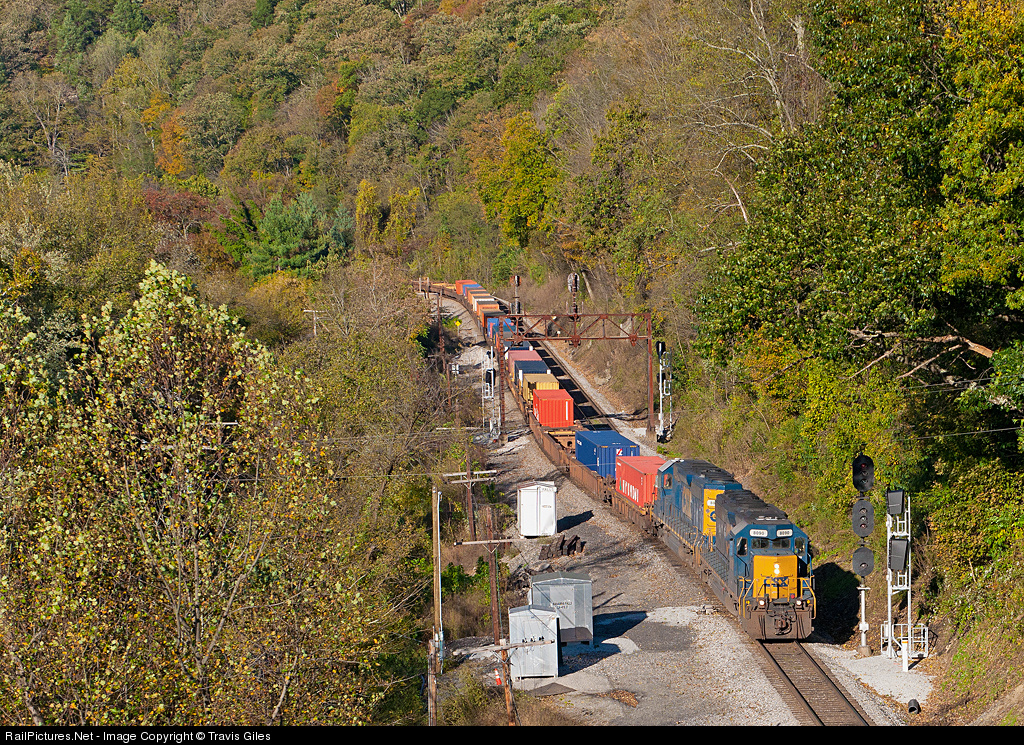Signaling news this year has been an absolute disaster and it's not over yet. This time one or both of the three track N&W signal bridges at HULL interlocking are being prepped for replacement. So far only one gantry appears to be under threat, but if this is a full re-signaling then expect both to come down. For a bit of background this is possibly the only pair of 3-track N&W style CPL signal bridges that exist anywhere. While common on the PRR, the N&W was always more restrained with its infrastructure and HULL interlocking was one of the few 3x3 crossovers to be found on the system. The interlocking is located in Iaeger, West Virginia.
A blog devoted to explaining the ins and outs of North American railroad signaling, past, present and future. This blog seeks to preserve through photo documentation the great diversity and technical ingenuity of 20th century signaling and interlocking hardware and technology. Related topics cover interlocking towers and railroad communications infrastructure.
Note, due to a web hosting failure some of the photos and links may be unavailable.
Search This Blog
Sunday, October 30, 2011
NASBY Re-Signaling Update
It appears that whatever NS has planned will involve a new interlocking at MP 293 taking the place of the NYC/Conrail style automatics near Ware Road. As is common on the western Chicago Line these autos consisted of a Conrail type mast and an NYC type bracket. The mast supplemented the bracket when the introductions of doublestacks ruined the sight lines.
Unfortunately they are also re-signaling the CP-295 interlocking which in addition to some NYC masts and a bracket, also has a searchlight dwarf stack off the siding.
Unfortunately they are also re-signaling the CP-295 interlocking which in addition to some NYC masts and a bracket, also has a searchlight dwarf stack off the siding.
Tuesday, October 25, 2011
No Surprises on the Cumberland Sub
Well it took less than a year after CSX replaced the CPLs on the Magnolia Cutoff for them to return and finish the job between Orleans Road and Hancock. While the Cuttoff was known for its use of bracket masts, this section was all about the 3-4 track B&O signal gantries. Just about the only good news is that all of these signals are accessible by a rough public road built on the empty part of the right of way. I hope to get out there myself in coming weeks. Anyway, I was tipped off by photos showing new Darth Vader signals already going up at GRASSHOPPER HOLLOW, which miraculously survived the closure of HANCOCK tower in 2007.
Tuesday, October 18, 2011
C&O Resignaling Marching Up The New River Sub
If you are looking to take an Amtrak trip I might recommend taking advantage of the dome car when it appears on the Cardinal in a week or two because it appears that CSX has really set its sights on re-signaling the New River Sub and its classic C&O signals. Fortunately I have managed to cover this section twice, but they were hardly under ideal conditions. I had hoped to get back next year, but I am not sure how much will be there to await me. Anyway the bad news is that the C&O towns of Prince and Thurmond will soon be sterilized and rendered useless for future generations of railfans so take a road trip out there while you can.
Sunday, October 16, 2011
PHOTOS: METRA 16TH ST CROSSING
Known as 16th St Junction or 16th St Crossing, the complex flat junction just south of Chicago's famous loop is the survivor of what used to be a dynamic duo of towers that shepherded some of the nation's flagship passenger trains in and out of downtown Chicago from points easth. Working opposite 16TH ST was the far better known 21ST ST (aka Alton Junction) and its 20 diamonds, but both towers were of such importance that both towers ended up with profile pages on signalbox.org.
16TH ST was located at the crossing of the Chicago and Alton route to Saint Louis and the southwest, the Saint Charles Air Line (jointly owned by the Illinois Central and Chicago, Burlington and Quincy) which provided cross-town freight service with the parallel north south Chicago, Rock Island and Pacific and New York Central (Lakeshore and Michigan Southern) main lines into the iconic LaSalle Street Station. Less than a mile to the west was 21ST ST owned and operated by NYC arch enemy Pennsylvania Railroad with smart brick structure with a Union Switch and Signal interlocked pneumatic plant. If back in the day one had asked which tower would still be up and functioning in 2011 one would have surely assumed the PRR plant, as it was nearly 40 years 16th St's junior and made of more durable materials. However not only was 21St ST closed in 2005, it was completely demolished(!) a few years later leaving 16TH ST to soldier on alone.
Today 16TH ST junction is much reduced from its heyday, but it is still complicated enough to protect the tower from any sort of hasty re-signaling scheme. The Chicago commuter rail authority, Metra, owns and operates the tower as part of its Rock Island division. The parallel NYC main was removed in the early 1970s when Amtrak shifted all passenger operations to Union Station. The former Alton route was merged into the GM&O before that merged with the Illinios Central and was eventually absorbed into Canadian National. The Saint Charles Air Line is now owned jointly by UP, BNSF and CNIC and used for various through-routings as well as Amtrak trains accessing the former IC Main Line to downstate Illinois and eventually New Orleans. A diagram of 16TH ST as it appeared in 1931 can be seen here.
16TH ST interlocking is not trivially accessible as it is in the middle of a large brownfield area next to the Chicago river, fenced off from the public. The best way to photograph it outside of riding the Railfan Window equipped METRA Gallery Cars is from the adjacent Orange Line that runs between Midway airport and The Loop. Even then you're going to need a good zoom.
Before we begin I would like to mention that the large format photos are not mine and were provided by one of my sources for this and other explanatory essays. Also the full set of non-captioned photos can be viewed here.
Here we see 16Th St from the southeast showing off the plain black on white lettered nameplate and the operator's parking lot. In the background we can see Roosevelt Ave which provides a popular photo location at the mouth of Chicago Union Station across the river.
As the Orange Line crosses the Rock Island division tracks we see the 68/69 trailing crossover and the 56 switch which forms a wye connection to the Air Line. That connection contains one of the interlocking's more unique features in the form of a diamond crossing over track 2 due to the originally constrained space creating too tight an angle for the track to connect in the usual fashion.
Here we see the tower end on with the CTA Red Line emerging from the downtown tunnel just past the former Alton tracks.
Finally we have a nice high res closeup of the east side of the tower and yeah...its a handyman's dream. Compared with the 1958 pics on Signalbox.org you can see that the siding dates from at least that time. The tower has developed a bit of a sag and half the windows are boarded up internally. Just about the only thing that isn't patched and falling apart is the roof, which was clearly replaced recently. The ladder is some sort of fire code thing, although I don't see how anyone could ever access it. I would not expect this tower to be preserved or to live on much past its eventual closure. It is too small to make a useful C&S/MoW base and its structural integrity probably leaves much to be desired. Also in urban environments towers like these tend to catch fire after being closed although this one standard a good chance of going up even before then.
Here is a diagram of how the interlocking appeared in 1931 with the combined New York Central/Rock Island 4-track trunk line crossing the St. Charles Air Line and Illinois Central lines with assorted connecting tracks. The GRS model 2 machine was far less advanced than the US&S equivalents, which relied more on electric logic. As such points are not worked in pairs so a crossover requires two lever slots (although one lever is a phantom internally slaved to the first). Furthermore signal head gets its own lever and combined with traffic levers for the diamond crossings and lock levers for who knows what one can see why the machine has over 150 total levers.
Here is a photo of the well worn model board as it appears today. Put in the perspective of something made 110 years ago this fully electric display board must had the same impact large LCD screen does today as many GRS/Taylor plants still relied on static diagrams and individual tracks circuit indicators. A great many of the removed lines have been painted over and many of the original labels have been replaced by stick-on labels or new painted ones. Today there are surprisingly few turnouts, but the nexus of different ownerships have maintained the status quo.
The diagram is fairly self-explanatory, but in case you are having trouble to the left and right we have the Metra Rock Island tracks. To the north are the two tracks of the CNIC Chicago Sub. To the bottom right we have the CNIC Freeport Sub and to the bottom left we have the Air Line.
Part of the interlocking was re-signaled probably in the 1980s creating a logically separate "North End" where the two main tracks split into 3 for the final mile into LaSalle St Station. The North End represents where the majority of routing decisions have to be made for METRA trains, although the 68/69 switch is used to get trains between track 1 north and track 2 south. The panel is a fairly basic NX push button unit with a fairly minimal display. Like police radios the panel has attracted a number of Banana stickers and, hopefully, a Kitchen Aid logo. The panel makes use of US&S style signaling numbering with L and R suffixes.
According to the Signalbox.org profile 16TH ST was built in 1901 with a 152 lever General Railway Signal Model 2 "pistol grip" interlocking machine. This was a very early example of this machine and used a beefed up version of the Taylor machine grip handle instead of the more iconic "pistol grip" that later became standard. This hybrid machine is the missing link that shows the direct lineage between the Taylor Model 2 (as seen in Willows Tower) and GRS Model 2. If this machine was actually built in 1901 that would indicate some overlap between the Taylor and GRS production runs and as you can see in the 1931 diagram even that is labeled Taylor so exactly how this machine was being branded and sold at the time is a bit uncertain.
Turning right from the model board to look along the GRS Model 2 power frame we can see that this tower is really a dump inside and the plastic sheeting over the windows is an indication of the heroic attempts by operators to keep Chicago's famous wind at bay.
Scooching down a bit to about lever 64 we can get a sense of the number of spare spaces that have developed on the main frame as the plant was rationalized over the tower's 11 decades of service. In the far right corner we can see the 48 lever GRS Model 5 machine that was installed sometime in the 20's or 30s to control a seperate logical section that contained some combination of crossovers with the New York Central, south of the main plant. While these have been completely removed, the old model board and interlocking machine have been remarkably preserved.
Also of interest in this photo are the 68 and 69 levers for the last remaining crossover in the interlocking plant. Because the high voltage current that ran the point machines were routed through contacts on the levers, the pistol grip style machine was limited to powering one set of points per lever due to the electric current limitations of these contacts. Crossovers thus had to use two lever spaces, but were worked in tandem from a single pistol grip with the second lever being omitted. These phantom levers for crossovers are marked with a (#) on the diagram.
Looking back in the opposite direction toward lever 1 from lever 145 we can see the placement of the model board, microwave over and other assorted debris.
16TH ST was located at the crossing of the Chicago and Alton route to Saint Louis and the southwest, the Saint Charles Air Line (jointly owned by the Illinois Central and Chicago, Burlington and Quincy) which provided cross-town freight service with the parallel north south Chicago, Rock Island and Pacific and New York Central (Lakeshore and Michigan Southern) main lines into the iconic LaSalle Street Station. Less than a mile to the west was 21ST ST owned and operated by NYC arch enemy Pennsylvania Railroad with smart brick structure with a Union Switch and Signal interlocked pneumatic plant. If back in the day one had asked which tower would still be up and functioning in 2011 one would have surely assumed the PRR plant, as it was nearly 40 years 16th St's junior and made of more durable materials. However not only was 21St ST closed in 2005, it was completely demolished(!) a few years later leaving 16TH ST to soldier on alone.
Today 16TH ST junction is much reduced from its heyday, but it is still complicated enough to protect the tower from any sort of hasty re-signaling scheme. The Chicago commuter rail authority, Metra, owns and operates the tower as part of its Rock Island division. The parallel NYC main was removed in the early 1970s when Amtrak shifted all passenger operations to Union Station. The former Alton route was merged into the GM&O before that merged with the Illinios Central and was eventually absorbed into Canadian National. The Saint Charles Air Line is now owned jointly by UP, BNSF and CNIC and used for various through-routings as well as Amtrak trains accessing the former IC Main Line to downstate Illinois and eventually New Orleans. A diagram of 16TH ST as it appeared in 1931 can be seen here.
Before we begin I would like to mention that the large format photos are not mine and were provided by one of my sources for this and other explanatory essays. Also the full set of non-captioned photos can be viewed here.
Here we see 16Th St from the southeast showing off the plain black on white lettered nameplate and the operator's parking lot. In the background we can see Roosevelt Ave which provides a popular photo location at the mouth of Chicago Union Station across the river.
As the Orange Line crosses the Rock Island division tracks we see the 68/69 trailing crossover and the 56 switch which forms a wye connection to the Air Line. That connection contains one of the interlocking's more unique features in the form of a diamond crossing over track 2 due to the originally constrained space creating too tight an angle for the track to connect in the usual fashion.
Here we see the tower end on with the CTA Red Line emerging from the downtown tunnel just past the former Alton tracks.
Finally we have a nice high res closeup of the east side of the tower and yeah...its a handyman's dream. Compared with the 1958 pics on Signalbox.org you can see that the siding dates from at least that time. The tower has developed a bit of a sag and half the windows are boarded up internally. Just about the only thing that isn't patched and falling apart is the roof, which was clearly replaced recently. The ladder is some sort of fire code thing, although I don't see how anyone could ever access it. I would not expect this tower to be preserved or to live on much past its eventual closure. It is too small to make a useful C&S/MoW base and its structural integrity probably leaves much to be desired. Also in urban environments towers like these tend to catch fire after being closed although this one standard a good chance of going up even before then.
Here is a diagram of how the interlocking appeared in 1931 with the combined New York Central/Rock Island 4-track trunk line crossing the St. Charles Air Line and Illinois Central lines with assorted connecting tracks. The GRS model 2 machine was far less advanced than the US&S equivalents, which relied more on electric logic. As such points are not worked in pairs so a crossover requires two lever slots (although one lever is a phantom internally slaved to the first). Furthermore signal head gets its own lever and combined with traffic levers for the diamond crossings and lock levers for who knows what one can see why the machine has over 150 total levers.
The diagram is fairly self-explanatory, but in case you are having trouble to the left and right we have the Metra Rock Island tracks. To the north are the two tracks of the CNIC Chicago Sub. To the bottom right we have the CNIC Freeport Sub and to the bottom left we have the Air Line.
Part of the interlocking was re-signaled probably in the 1980s creating a logically separate "North End" where the two main tracks split into 3 for the final mile into LaSalle St Station. The North End represents where the majority of routing decisions have to be made for METRA trains, although the 68/69 switch is used to get trains between track 1 north and track 2 south. The panel is a fairly basic NX push button unit with a fairly minimal display. Like police radios the panel has attracted a number of Banana stickers and, hopefully, a Kitchen Aid logo. The panel makes use of US&S style signaling numbering with L and R suffixes.
According to the Signalbox.org profile 16TH ST was built in 1901 with a 152 lever General Railway Signal Model 2 "pistol grip" interlocking machine. This was a very early example of this machine and used a beefed up version of the Taylor machine grip handle instead of the more iconic "pistol grip" that later became standard. This hybrid machine is the missing link that shows the direct lineage between the Taylor Model 2 (as seen in Willows Tower) and GRS Model 2. If this machine was actually built in 1901 that would indicate some overlap between the Taylor and GRS production runs and as you can see in the 1931 diagram even that is labeled Taylor so exactly how this machine was being branded and sold at the time is a bit uncertain.
Turning right from the model board to look along the GRS Model 2 power frame we can see that this tower is really a dump inside and the plastic sheeting over the windows is an indication of the heroic attempts by operators to keep Chicago's famous wind at bay.
Scooching down a bit to about lever 64 we can get a sense of the number of spare spaces that have developed on the main frame as the plant was rationalized over the tower's 11 decades of service. In the far right corner we can see the 48 lever GRS Model 5 machine that was installed sometime in the 20's or 30s to control a seperate logical section that contained some combination of crossovers with the New York Central, south of the main plant. While these have been completely removed, the old model board and interlocking machine have been remarkably preserved.
Also of interest in this photo are the 68 and 69 levers for the last remaining crossover in the interlocking plant. Because the high voltage current that ran the point machines were routed through contacts on the levers, the pistol grip style machine was limited to powering one set of points per lever due to the electric current limitations of these contacts. Crossovers thus had to use two lever spaces, but were worked in tandem from a single pistol grip with the second lever being omitted. These phantom levers for crossovers are marked with a (#) on the diagram.
Looking back in the opposite direction toward lever 1 from lever 145 we can see the placement of the model board, microwave over and other assorted debris.
Subscribe to:
Posts (Atom)
